Guide to Boreal Birds
Overview
This secretive grouse is easy to find in winter, when snow covers the ground and the birds fly up into the treetops to feed on buds and catkins. The summer diet, much more varied, consists of insects, seeds, fruits, and even an occasional small snake or frog. Long one of the most highly esteemed game birds in North America, the Ruffed Grouse can withstand hunting pressure as long as suitable habitat exists. But in many areas forests are maturing, eliminating the undergrowth this species needs; where this is happening, reintroduced Wild Turkeys are increasing and the grouse are decreasing. The Ruffed Grouse is also the state bird of Pennsylvania.
Description
16-19" (41-48 cm). A brown or gray-brown, chicken-like bird with slight crest, fan-shaped, black-banded tail, barred flanks, and black "ruffs" on sides of neck.
Voice
Female gives soft hen-like clucks. In spring displaying male sits on a log and beats the air with his wings, creating a drumming sound that increases rapidly in tempo.
Nesting
9-12 pinkish-buff eggs, plain or spotted with dull brown, in a shallow depression lined with leaves and concealed under a bush.
Habitat
Deciduous and mixed forests, especially those with scattered clearings and dense undergrowth; overgrown pastures.
Range/Migration
Resident from tree line in Alaska and northern Canada south to California, Wyoming, Minnesota, Missouri, and Carolinas, and in Appalachians to Georgia.



